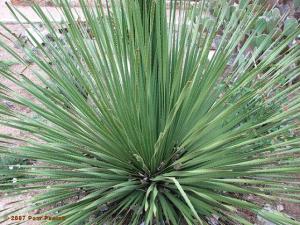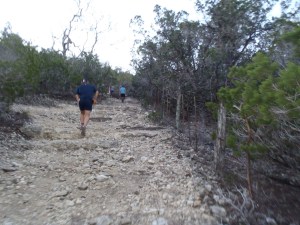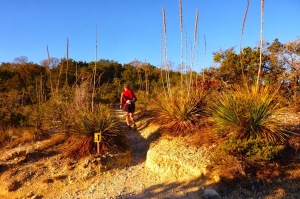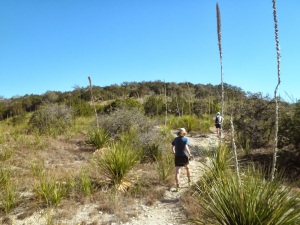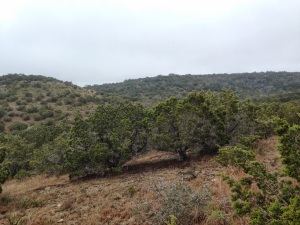Written by Avery Frantz - https://averyfunadventure.wordpress.com

The Finisher’s Buckle
Summary
“Sometimes you bite off more than you can chew but somehow, some way you must find a way to make it work.”
The Bandera 100k is a two loop course through the Texas Hill Country. It is not at high elevation but over the course (according to my Garmin) you gain over 2200m/7200ft. There are parts that consist of double track, single track, rocky single track, tough rocky ascents and descents, and portions that simply were not runable for me. Rocks, rocks, and more rocks would be the best way I could describe this race.
The race itself is very well organized. The race director provided very useful information. The course (except for a wind-blown portion at night) was very well marked. The aid station volunteers were the best. They were so positive and supportive. Since I had no crew on this trip, I relied on them heavily. I really can’t say enough positive things about them. If you ever want to run races in Texas, check out Tejas Trail events.
Leading up to this race, I started training in September. I put in a three part training regimen that got progressively more difficult with harder weekly speed work sessions along with treadmill ascent/descent workouts. I ran on abandoned railroad tracks to try to simulate uneven terrain. I felt pretty strong coming into the race having completed one of my best long training runs of my life (71km in 6:45) only 3-4 weeks prior. However, the day before the race I did a small training run on the beginning of the course and had to reset my expectations when I saw how difficult the terrain would be for me. The rocky condition was something I was completely unfamiliar with and had no opportunity to train on living in the flat Yucatan in Mexico. This would be my first trail ultra and second ultramarathon.
Race Start
It was a cold morning when the race started with temperatures around 5°C/41°F. It actually wasn’t too cold for me once we got started but waiting around I found myself fighting off the shivers. When we took off from the start, I was in between the front and the middle of the pack. The path to the first aid station begins with some easy double track. Yet I knew that this would only last minutes before I had to deal with some rocky climbs that required walking/hiking. After getting to the top of a plateau, we had to drop down to the backside and this section also introduced me to the evil sotol plant. It looks like a smaller cousin to the agave cactus but it has sharp teeth on the edge of the leaf. These plants lined many portions of the course and slice your legs as you run by piercing your skin with tiny little punctures. By the time I got to the first aid station named Nachos, I had blood running down both legs and it would repeat throughout the day. It hurt but not too bad, just enough to be quite annoying. I hit the first aid station about 10 minutes slower than I wanted to–foreshadowing of the day to come.
At this point, I took off my windbreaker, filled up on some Tailwind, and got out of the aid station in 2.5 minutes. For the most part I kept my aid stations stops efficient. They were generally between 1-3 minutes with the two longer ones, of 5-6 min, due to refilling my hydration pack and to get my headlamp and windbreaker back on as the sun was setting.
The next section was supposed to be a faster and flatter by what I read and was told, but it still went slower for me due to my inexperience with running on jagged large rocks. I felt like I had to run more tenuously than I wanted. In fact, during this portion, my frustration began to mount. I wanted to “open up” the engine and fly but instead I had to hold back on this terrain. Arriving at the Chapas aid station, I checked the watch to see I was so far behind the pace I wanted that even hitting my C goal was going to be tough. I already threw out my A goal the day before on my training run and my B goal was toast when I saw how slow it took me to get to the first aid station. My mind was not happy.
Coming out of Chapas, it should have been my true chance to fly because of the relatively flat dirt track. I stress SHOULD have been. Instead this was the portion where my knees began to ache. First my left one, via what felt like IT band issues, and then my right began to hurt worse and in a larger area. By the time I hit the 3 hour mark, I was in considerable pain and started questioning this whole endeavor. What kind of race is this where I’m already wondering why I’m doing it and we have only run for 3 hours??!! I arrived at the Crossroads 1 aid station in a bad state of mind. I refilled and began the section which probably ruined any chance of having the ability to make up time.
It was a very rugged section of terrain with–wait for it–more rocks and two tough climbs. Again I felt myself simply trying to bound side to side on large and small rocks and not fall/die. When you finish, it takes you to the Crossroads 2 aid station–which is the same as Crossroads 1 but on the other side of it. My arrival this time had me at a whole new level of pain in my knees.
Leaving Crossroads 2 and for the next hour or so, I deeply contemplated dropping out of the race. I even wished that I did fall, had a more acute injury, or maybe have some animal attack me, just something that would give me a good excuse to stop. I went deep into the dark recesses of my mind and thoughts. I played out different scenarios of how to drop. If I didn’t get that animal attack I desired, I entertained the idea of just doing the 50km race. The race director stated that if you signed up for the 100km, you could do 50km and stop and have your time count as part of the 50km race. Hmmm, maybe this was doable for me. Then I thought of my daughters, Fiona and Gianna, and their shining faces when they talk about Daddy’s races. How could their hero look them in their face and tell them he didn’t finish his race? How could I be a man of my word if I stopped because I didn’t get the result I wanted? This loop of negative “I feel sorry for myself” thoughts replayed several times as I ascended one hell of a climb which of course was followed by a technical descent. While on the ascent, I struggled to even hike a few of the huge stone steps ranging 2-3 feet in height. I commented to some other runners that I have no idea how I’m going to be able to do this the second time in the dark. I arrived at the Last Chance aid station filled up and set out for the end of the first loop.
This last section puts you through another tough rocky climb and back to the plateau from the beginning of the race eventually forcing another painful, technical descent onto the only portion that I truly enjoyed–the double track to the start/finish line. I think it was in this section that I realized I had been cursing more this day than I had in the past few years combined. I am a father of three lovely daughters and work hard to watch what I say but if one were to have heard me they may have mistaken me for an old school military man. I wanted all the rocks to be eradicated from the face of the Earth. They were the bane of my existence. I hit the halfway point of the race in 5:57:28–roughly an hour slower than I had wanted.

A funny thing happened while I refilled my supplies and headed back out–I never considered stopping. I was in the middle of the ascents in the first portion of the course before I realized I forgot about the silly idea of quitting. My knees didn’t get any better but I think my brain figured out that I wasn’t going to give in to the idea of dropping so it stopped bothering me with the idea. While my mind was in a better state, the fact of the matter was that I continued to slow on the technical portions of the course. It took me 20 minutes longer to reach the Nachos aid station the second time.
From Nachos to Chapas, I think I started to get a bit “lazy”. What I mean is that a handful of times, I ended up behind a some runners who would descend faster than I but on the climbs and flats I would catch back up. Instead of asking to pass and run my own pace, I simply tailed them which meant I was going about 10% slower than I would have normally run. Looking back I think I did this one or two times more in the second half of the race. I think in my fatigued state, my mind enjoyed going at a more leisurely pace and I zoned out. Finally it dawned on me to stop this nonsense, ask to pass, and go. Each time I did, I never ended up seeing those runners again. Who knows how much time I lost by not pushing my way though? Definitely food for thought in the future.
The next segment, Chapas to Crossroads 1, was another portion that I wish I could have run without knee pain. Like the first time I came through, I just kept thinking about how it would be nice to really let loose and run with authority. Instead I let my knee pain reduce my stride to a quasi-shuffle thus reducing my speed. I came into the aid station pretty much fed up with this ongoing pain. My coach was waiting for me there and was asking me how I was doing. He said I looked good…I laughed! After explaining to him what had been happening, he suggested some changes to my running mechanics. Amazingly enough I shot out of the aid station with much more spring in my step. The slight change to my stride helped reduce some of the pain and I was able to pick up the pace.
The second time through Crossroads 1 to Crossroads 2 was a small success for me. I was able to complete it in the exact same time as the first pass. I don’t know if it was a matter of getting out of the aid station with a faster pace or the fact I knew I just wanted to finish but somehow I pushed through more efficiently. During this segment I ran a bit with the winner for the 55-59 age group. We ran over half the section together and the chatting helped quite a bit. I think this was his 7th time running the race. My hats off to him for running this thing so many times.
Coming out of Crossroads 2, it was already dark. You could imagine that with it being my first time on this rugged terrain with only a headlamp for light that things would be precarious at best. This was also the section I dreaded the first time because it had such a steep incline and decline plus I had to do it again at night. Wouldn’t you know that I completed it 2 minutes faster than the first time? I think the fact that it was dark and I couldn’t see how high I had to climb and how far I had to descend kept me from overthinking. Finishing this portion, 11 hours and 45 minutes had going by since the start of the race. Now my personal goal was to finish under 13 hours.
From Last Chance aid station to the end, I was pretty much in a robotic mode of just get the race done. It was tough terrain summiting the same plateau from beginning of the course but I kept pushing and passed a few runners. With only 3 km/2mi to go, I started to wonder if I ran off course. The entire course has lots of arrows and ribbons with reflectors yet I hadn’t seen one in a good 10-15 minutes. I started looking at the ground for footprints. I found a muddy section but the only prints I saw were that of a mountain lion or bobcat–not what I was looking for nor did I want that animal attack any more!!! After a few more minutes full blown panic set in. I stopped, turned off my headlamp, and looked around. I saw no lights behind me or in front of me. I couldn’t hear the finish line. Was I off course? Was I lost? This is not what I wanted after almost 13 hours of the race. I decided to backtrack and either find a course marking where I went off course or another runner. After about 3-4 minutes I found a runner and confirmed with him that this was the right way. I ended up pulling away from him but still didn’t see a marker that he swore was there–I started to doubt this runner. Finally after another 10 minutes I saw a reflective ribbon. Ten minutes was probably lost during this error of mine. I pushed down the difficult descent to the last stretch of dirt trail. I looked at my watch and it read 12:54. Time to fly! I really wanted a sub 13 time–just some sort of goal to be met since none of my original goals were achieved. As I got closer to the finish line, I could see the clearing and went for it. I ran the last half of a kilometer at a 4 min/km pace and flew across the finish line. I looked back at the clock and it read 12:58:39. A small victory for me to end the day!
Wrap Up
Like many have said before, each race, each adventure teaches us something new. This race was no different. First and foremost, I had a large dose of reality and humble pie regarding terrain and specificity of training. I spent the last four months training for this race. I got stronger, faster, and built more endurance than I have ever had in my life. Yet when it was all said and done, I felt like I arrived to a new country with pockets full of cash but in the wrong currency. The currency needed for this course was that of running on rocky ascents and descents and I had none of it. Had this been dirt trails with no rocks, I can confidently say I think I could have finished at least two hours faster. I will not choose races in the future where I don’t have access to the same terrain or sufficient alternative means to match the conditions.
This reinforced the value in sticking with it no matter how dark things get in your mind. You can power through those moments and find what it takes to reach the finish line. It may not be in the time you would have hoped but the experience is something you will grow from and use the rest of your life. Not that I didn’t respect the top ultra runners out there but after experiencing this course up close and personal, it gave me an even deeper appreciation for those runners who can practically fly on this terrain.
Looking back on my numbers from the race, I see evidence that I was in good condition. The fact that I ran a few sections at the end at the same pace or faster than the first loop tells me that my base fitness is good. The final half kilometer “sprint” tells me that I still had plenty of strength to endure.
The day after the race my spirits were remarkably high. I was able to recognize that I did accomplish something special. One hundred kilometers is not your standard walk in the park. It is something that, no matter your skill level at running, requires plenty of training, patience, and perseverance. I will seek out some more adventures this year albeit races in which I can be adequately prepared.
Comparing my two ultramarathons, I would say that the Bandera 100k is harder than the Keys 100. Even though the Keys 100 is 61km farther, my body didn’t suffer in the same manner as in Bandera. The good news is now I’ve run my very first qualifier for Western States which means I can officially put my name in the lottery for the 2017 race.





